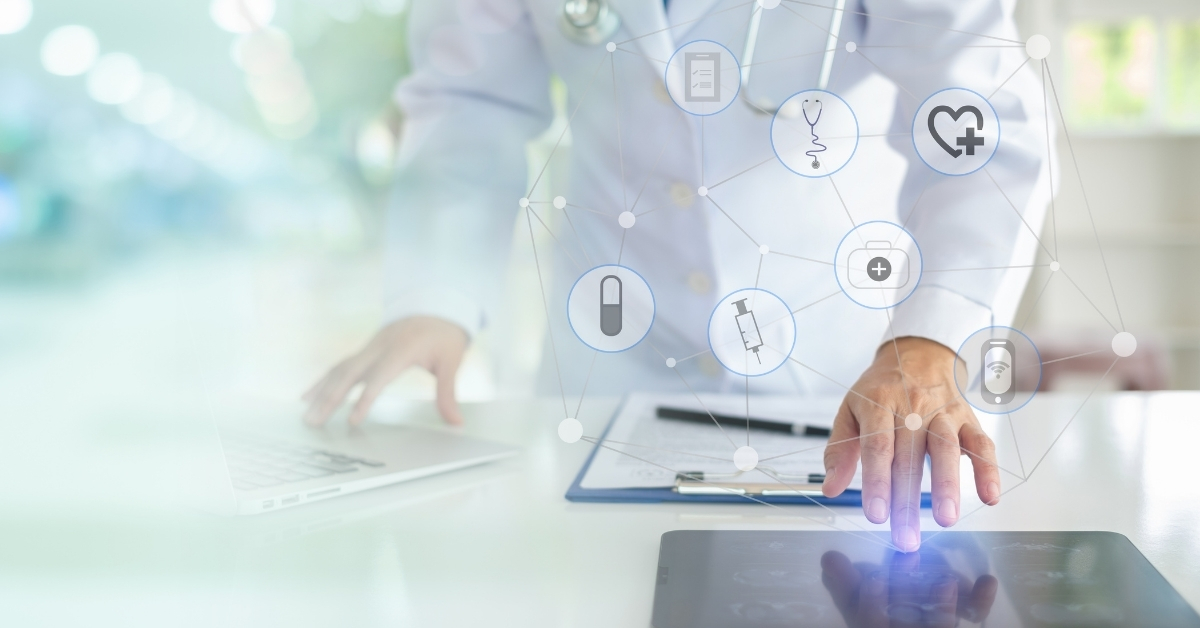Today, healthcare information is changing and the ways of accessing it, sharing it, and finding better ways of using the data are growing exponentially. Whether focusing on the clinical care aspect or the healthcare billing lifecycle, the Electronic Health Record (EHR) is the central hub where each patient’s key information can be accessed and stored.
Until recently, seamlessly integrating with the EHR has been difficult as technological barriers, security measures, and HIPAA-related concerns for patient privacy have dictated that patient health information be kept solitary. However, since COVID-19 and the public health emergency, the explosion of alternative care delivery models, such as Telehealth, have precipitated new protocols that allow more interaction with platforms that expand a physician’s ability to see and treat patients.
Over the last couple of years, companies as diverse as Walmart, Apple, and Pfizer have all developed applications that use EHR integration to interact with providers and healthcare systems to communicate information about patients. In fact, Apple’s Healthkit transmits health and fitness data directly from mobile devices and wearables into the patient’s EHR and cardiologists have access to advanced heart health and real-time biometric data based on wearable technology.
FHIR and EHR Integration
With Fast Healthcare Interoperability Resources (FHIR), the new data standard developed by HL7 International, becoming more widely available, EHR integration is much more functional and achievable. With FHIR, Application Program Interface (API) protocols provide a connection between computer programs and platforms allowing access to data regardless of the individual EHR system or software being used.
Creating this fluid language allows data to flow freely as it’s exchanged between interested parties. This will encourage systems improvement and cooperation among interested participants, from clinical care providers to insurance companies to the wide range of vendors providing everything from pharmaceuticals to billing services.
Additionally, this ‘superhighway’ of data will be especially helpful as organizations adopting value-based care models that promise to up-end payment models system-wide over the next couple of years.
Beyond Clinical Applications
Equally important to provider practices and hospitals, the financial reimbursement process is finding EHR integration to be a valuable resource when bringing advanced automation to the healthcare billing lifecycle. Burdened with an instilled third-party payer system, healthcare providers must apply for payment through a complex, multi-faceted process all to receive discounted payment for their services.
Opportunities to streamline the overall workflow supported by EHR integration include everything from verifying a patient’s insurance coverage and asking for advanced approval of many care options to coding, billing, and claims management.
Patient Access
When it comes to patient access functions, or onboarding patients before care is provided, EHR integration is proving to be crucial in the development and implementation of cloud-based software options in these areas where there is still significant manual work being done:
-
Insurance Verification — real-time verifications done with every patient encounter ensures billing will be sent to the correct payer. When integrated with the EHR, it also signals the provider of eligible treatment options or limitations during a patient’s visit to allow immediate customization of care options.
-
Benefits — Knowing the patient’s type of plan, co-pays, deductibles, out-of-pocket maximums, and remaining deductibles ensure that the reimbursement collected is correct.
-
Prior Authorization — With prior authorizations being required on more (not less, as hoped) procedures, tests, and medications, an integrated EHR working in tandem with an AI-assisted prior authorization software system makes processing, submitting, and following up significantly more streamlined. This also allows the provider to be cognizant of the need for a prior authorization during the patient encounter so that expectations can be set in real-time.
-
Insurance Discovery — Using AI and machine learning, providers and hospitals can now sweep existing databases to check for undisclosed insurance coverage that may include secondary coverages, Medicaid or Medicare, and most commercial insurances.
Revenue Cycle Management
Following a patient encounter, EHR integration becomes an integral part of the entire revenue cycle management (RCM) process.
-
Coding and Billing — Whether using a third-party coding and billing partner or an automated, in-house system, EHR integration is imperative to ensure accurate, precise coding and billing. Without an exacting coding process, reimbursement would be at risk of non-collection for practices and hospitals operating on already thin margins.
-
RCM and AR Optimization — From managing denied claims to prioritizing workflow to analyzing business-critical analytics, access to real-time patient information through EHR integration is key to automation-facilitated business processes. With more than 2/3’s of denials going unworked with the revenue simply abandoned, using an AI-driven digital technology that can interface directly with the patient’s EHR ensures revenue is collected and write-offs reduced.
Final Thoughts
Healthcare revenue continues to dwindle for both provider practices and hospital systems. By utilizing the information that is already available within the EHR – the anchor for both clinical and reimbursement-related functions – today’s digital technology can more readily facilitate quality patient care and maximized reimbursement.
At Infinx, we have developed fully realized products that answer many of these business functions from patient access through final payment. Utilizing cutting-edge technology, including AI-assisted software and machine learning, our solutions answer many of today’s reimbursement problems and allow you to bring more to your bottom line.
Request a demo with us today to learn more about our patient access functions such as improved prior authorizations, or to view our new RCM Platform that optimizes your AR and improved your bottom line utilizing EHR integration.
